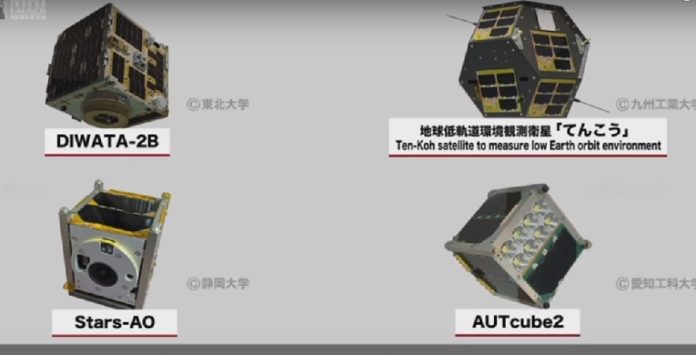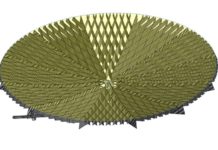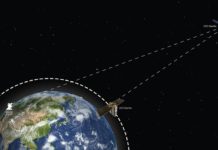Today, at 1:08pm JST (GMT+9), Japan’s space agency JAXA launched two Earth Observation (EO) satellites – KhalifaSat, the first satellite developed entirely by the UAE, as well as GOSAT-2, which will measure greenhouse gases from space. Piggybacking on these 2 main payloads were the Philippines’ microsatellite Diwata-2 and three cubesats from Japanese universities.
The launch took place at JAXA’s Tanegashima Space Center using Mitsubishi Heavy Industries’ H-IIA launch vehicle, which can take 10,000–15,000 kg to Low Earth Orbit (LEO) depending on its configuration. JAXA confirmed the separations of GOSAT-2 and KhalifaSat at approximately 16 min 9 sec, and 24 min and 15 sec, after liftoff, respectively.
GOSAT-2
GOSAT-2 (Greenhouse gases Observing SATellite-2), developed by Japanese scientists from various institutions including JAXA, is the successor of GOSAT, launched in 2009. Also known as Ibuki-2, GOSAT-2 will continue GOSAT’s work of measuring the atmospheric concentration of carbon dioxide (CO2) and methane (CH4). By monitoring such greenhouse gases, the GOSAT-2 mission hopes to monitor the impacts of climate change and human activities on the carbon cycle, and contribute to the understanding of climate change.
GOSAT-2 will operate at a 613 km Sun Synchronous Orbit (SSO) and has an approximate mass of 2,000kg with a design life of 5 years. The satellite carries two major payloads, FTS-2 (Fourier Transform Spectrometer) and CAI-2 (Cloud and Aerosol Imager 2). Both are upgraded versions of instruments aboard GOSAT.
FTS-2 will observe sunlight reflected by the Earth’s surface or scattered by clouds or aerosols, as well as thermal emissions from both the earth’s surface and atmosphere. CAI-2, a pushbroom imaging system with ten bands in the ultra violet, visible, near infrared, and short wavelength infrared regions, is able to measure aerosols over lands, including urban areas, and monitor transboundary air pollution.
KhalifaSat
The first satellite to be developed entirely by a team of Emirati engineers, KhalifaSat is a remote sensing satellite manufactured at the Mohammed bin Rashid Space Centre (MBRSC) in Dubai. Prior to this, the UAE space agency had developed two EO satellites, DubaiSat-1 and DubaiSat-2, in collaboration with Satrec Initiative, a South Korean satellite manufacturer.
Work on the KhalifaSat project, which was officially announced in 2013, began with the UAE team using Satrec’s facilities until those in Dubai were completed in 2015.
Like GOSAT-2, KhalifSat will operate at a 613 km SSO, and has a design life of 5 years. The 330kg satellite is equipped with a high-resolution pushbroom multispectral imager, which has a resolution of 0.7m for panchromatic imagery and 2.98m in four multi-spectral bands for visible and near infrared imaging. Imagery from KhalifaSat will be used for urban planning, environmental change monitoring, disaster relief and other purposes.
Diwata-2
Diwata-2 is the second satellite of the Philippine Scientific Earth Observation Microsatellite (PHL-Microsat) program, following Diwata-1 launched in 2016. The satellite was developed by the Philippine Department of Science and Technology (DOST), in cooperation with Tohoku University and Hokkaido University in Japan. With a mass of 56kg, and a design life of 5 years, Diwata-2 carries an amateur radio payload, a Spaceborne Multispectral Imager (SMI), and a high precision telescope (HPT). Besides being a demonstration satellite, Diwata-2 will be used for disaster relief efforts in the Philippines, with its instruments designed for communications, environmental monitoring, and post-disaster assessment. Today, Diwata-2 was launched by piggybacking on GOSAT-2.
Small satellites from Japanese universities
Along with these, today’s launch carried two other small satellites, all from Japanese universities. The largest is the 45kg the 22kg Ten-Koh, developed by Kyushu Institute of Technology. Interestingly, the satellite is Quasi-spherical and covered with solar cells, and will measure the degradation of advanced materials due to magnetic flux and radiation in the LEO environment.
Lastly, two 1U cubesats were orbited – AUTcube 2 by Aichi University of Technology with a mission to demonstrate Virtual Reality (VR) and satellite communication using LED bulbs, as well as STARS-AO by Shizuoka University, which carries a tiny telescope for astronomical observations.







